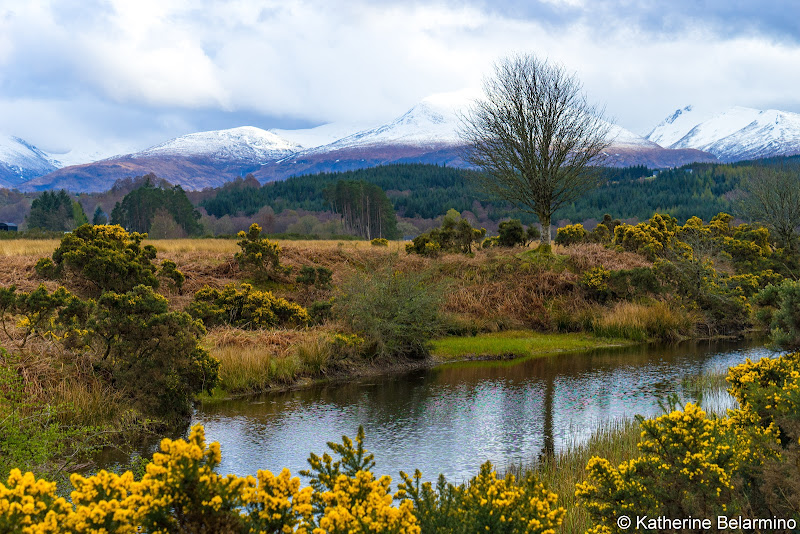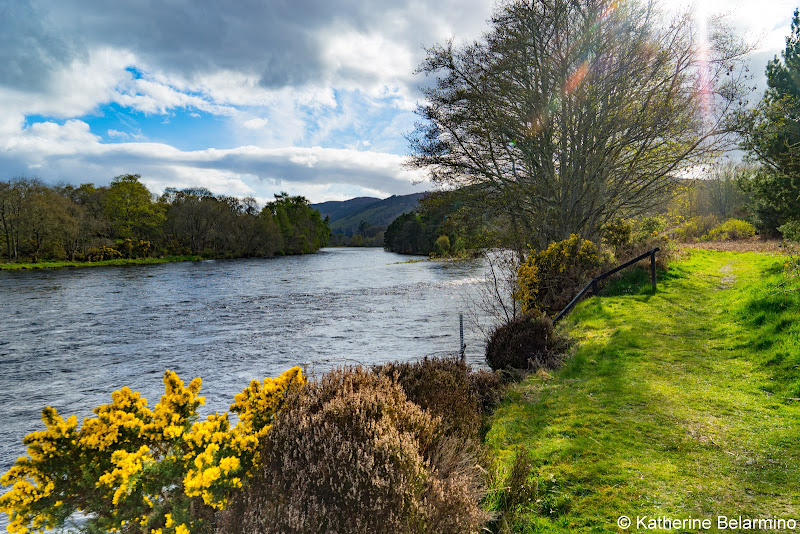The Scottish Highlands have two separate travel components. One includes castles and distilleries and other touristy sites. We found these were best enjoyed on a Scottish Highlands road trip. The second is the natural beauty of the Scottish Highlands. This second aspect of the Highlands is best enjoyed slowly. We found that the best way to enjoy the Scottish Highlands was on an active holiday on a Scotland cruise.
We joined a seven-day Caledonian Canal cruise with Caledonian Discovery, a company that runs barge cruises along the Caledonian Canal and through the lochs of the Scottish Highlands, including the famous Loch Ness. The cruise is kind of like a Scotland river cruise, except you travel through lochs and canals instead of a river. The following are some of the things we did and saw on our Scotland cruise to give an idea of what it’s like to explore the Scottish Highlands on a barge cruise.
Our barge cruise along the Caledonian Canal with Caledonian Discovery started in Fort William and ended in Inverness. We met the barge at the top of Neptune’s Staircase, a canal staircase of seven locks.
Nearby is Ben Nevis, the highest mountain in Scotland. Ben Nevis is popular with mountain climbers and is one of three mountains climbers summit as part of the National Three Peaks Challenge, which involves climbing the highest peak in Scotland, Ben Nevis, the highest peak in England, Scafell Pike, and the highest peak in Wales, Snowdon, all within 24 hours. While Ben Nevis is quite close to Fort William, you may or may not be able to see it during your trip. Locals use Ben Nevis to predict the weather. If you can see Ben Nevis, it’s going to rain. If you can’t see Ben Nevis, it’s raining.
The Caledonian Canal is crossed by 10 swinging bridges. Moy Bridge is the only remaining original cast iron twin leaf swing bridge on the canal. The bridge is operated by hand. The lock-keeper opens one side, then gets in a boat, crosses the canal, and opens the opposite side. The lock-keeper used to have to row across but recently started using a motor boat.
Where the canal empties into the first loch of our journey, Loch Lochy, a tiny white pepperpot lighthouse, Gairlochy Lighthouse, guards the entrance to the canal. The lighthouse, which is made of cast iron, is no longer in use.
We anchored in Bunarkaig Bay not far from Gairlochy and motored to shore for a little Scottish Highlands walking. We passed a little stone church called Saint Ciaran’s, the Clan Cameron Museum, and Achnacarry Castle, the ancestral home of the Chiefs of Clan Cameron.
The currently standing Achnacarry Castle is not the original. All that is left of Old Achnacarry is a stone chimney. The original was destroyed in 1746 by the Duke of Cumberland’s soldiers after the defeat of the Jacobite army at Culloden.
We crossed a bridge that separates Loch Arkaig and River Arkaig, then followed the river back, passing the Eas Chia-aig Waterfall on the way. The road back to the bay passed through a forest of moss covered trees and rock walls so covered in green they looked soft.
At the other end of Loch Lochy is Kilfinnan, an ancient burial ground. This is where the chiefs of the MacDonnells of Glengarry were buried. The burial ground that can be visited today is a replacement as the original was submerged with the building of the Caledonian Canal. The new burial ground has the MacDonell of Glengarry family mausoleum. Bishop Hugh MacDonald, who was buried at Kilfinnan, has connections to the Jacobite Rising of 1745 as he tried to warn the clan chiefs against the Rising. There is a memorial to Bishop Hugh MacDonald at the current burial ground.
Another spot worth a visit nearby, but not so ancient, is Eagle Barge Inn at Laggan Locks. The Eagle is a 1926 Dutch barge that has been converted into a restaurant and bar. It only makes sense when taking a barge cruise in the Scottish Highlands to visit a pub in a barge. On Sunday nights they have quiz night and the Ros Crana guest team, ahem, allowed the Caledonian Discovery crew team to win by just a few points. That’s our story and we’re sticking to it.
The next day we hiked while the barge cruised along the piece of the Caledonian Canal that connects Loch Cainn to Loch Oich. Loch Oich was my favorite loch simply because I love how it’s pronounced and it made me giggle inside whenever someone said Loch Oich (you can hear how Loch Oich is pronounced here).
The Great Glen Way along this part of the canal follows an old railway cut for the Invergarry and Fort Augustus Railway. The route was discontinued in the early 1900s. However, the Invergarry Station Project is working on preserving the old train station and creating a railway museum. There are currently some tracks laid and some old train cars on display.
Where the Caledonian Canal empties into Loch Oich is the Well of the Seven Heads. We didn’t get to visit this spot as we were walking the Great Glen Way, but others on our cruise did as they decided to canoe that day. The Well of the Seven Heads has a gory story. Men beheaded seven clansmen as revenge for a murder they had committed. They stopped at the pond and washed the heads in the pond before bringing them to the castle. Visitors to the memorial can also stop in for some tea and cakes at the Well of the Seven Heads Larder.
Farther down Loch Oich is Castle Bay where there is a two-for-one, a castle and a shipwreck! The shipwreck isn’t ancient, but it still looks pretty cool. The owner of the ship anchored it in a place that wasn’t protected enough to withstand the Scottish Highlands weather, so the ship took on water and sank.
The castle on the hill in ruins is Invergarry Castle. This was the seat of the MacDonells. The castle still stands but is in ruins and can only be viewed from the outside.
Nearby is also Glengarry Castle. We took a short walk to visit the shipwreck and castle and then, when it started to rain, took the opportunity to duck into Glengarry Castle for a lovely and inexpensive afternoon tea. We sat in the library, sipped tea, nibbled on cakes, and watched the sheep wander the grounds outside. This was also the first day of our trip that we saw a rainbow, which is rather shocking for Scotland. However, we saw not just one rainbow, but three, so Scotland made up for the rainbow absence.
A couple on our cruise actually live in the area and told us to keep on the lookout for hairy Highland cows (heilan coos), and one in particular who seems to enjoy having its picture taken. We’re pretty sure we found him.
I’ve always wanted to go on one of those hikes that doesn’t follow an actual hiking trail, but rather crosses over pastures, through random fences, over a rock wall, you get the picture. During our Scottish Highlands barge cruise we took one of these hikes as a group. It was described as a hike up a “wee hill.” It wasn’t a requirement and not everyone went. In fact Romeo cruised the canal while I joined the guided hike. While the barge slowly floated along the Caledonian Canal, we hiked through grassy fields, by newborn lambs, and up slightly steep hills until we were greeted with our first view of Loch Ness and the town of Fort Augustus, one of the largest small towns along the Caledonian Canal.
While the Scottish Highlands are the main attraction during a Caledonian Discovery cruise, expect to be the main attraction when leaving Fort Augustus. As we traveled down the chain of locks to depart from Fort Augustus, we were the focus of everyone along the canal. Tourists crowded the sides of the canal as we descended the set of five locks one by one, taking photos and even waving at us.
Something else we found rather humorous is that the sign that says Loch Ness, which stands in front of the loch, seems to be the most photographed spot in the Scottish Highlands. While we ate lunch on board the Ros Crana, we witnessed countless people stopping for a photo op. We even saw tour buses stop, let everyone out for a photo of the sign, then load up again and move on their way.
After we left Fort Augustus, we sailed through Loch Ness, constantly keeping an eye out for Nessie, then docked in Foyers Bay. There are a number of walking and hiking opportunities in Foyers Bay. We took a twilight walk after dinner along the Woodland Walk, a trail that follows the shore of a small peninsula. We were on the lookout for small wildlife and did get to see some bats swooping through the air feeding on bugs.
The next day we took another guided hike, this time to the Falls of Foyers. The Scottish poet Robert Burns was so taken by the falls, he wrote:
Among the healthy hills and ragged woods
The roaring Fyers pours his mossy floods;
Till full he dashes on the rocky mounds,
Where, through a shapeless breach, his stream resounds,
As high in air the bursting torrents flow,
As deep recoiling surges foam below,
Prone down the rock the whitening sheet descends,
And viewless Echo’s ear, astonished rends.
Dim seen, through rising mists and ceaseless showers,
The hoary cavern, wide surrounding, lowers.
Still, thro’ the gap the struggling river toils,
And still, below, the horrid cauldron boils.
Verses from this poem are scattered along the Falls of Foyers trail, written on plaques of stone. One thing Burns didn’t mention in his poem is the famous Foyers Effect. If you stare at the falls for about 30 seconds then look away, at a hill of trees for instance, the trees will look like they are moving in the same form as the falls, but in the opposite direction.
Above the falls is a little coffee shop, the Waterfall Café. Outside of the café is a red phone box, the Foyers Phone Box, which has its own Facebook page. Hiding inside the phone box is a cute little collection of gnomes.
Our trip continued to the other end of Loch Ness, which is famous for Urquhart Castle, one of the most visited attractions in Scotland. We didn’t get to visit the castle, but we had great views of the castle from the water.
Our journey through the Scottish Highlands finished by passing through Loch Dochfour and the part of the Caledonian Canal that runs parallel to the River Ness until we reached our final destination, Inverness.
When it was time to leave the barge for the last time and head to the train station, we were sad that our Scotland cruise through the Scottish Highlands had ended. Rome even commented that he wished it was a day or two longer. Cruising with Caledonian Discovery is a wonderful way to slowly explore the Scottish Highlands, and we can see why guests return again and again.
Thank you to Caledonian Discovery for hosting us on a Classic Cruise and making this post possible. As always, all opinions are our own.




































